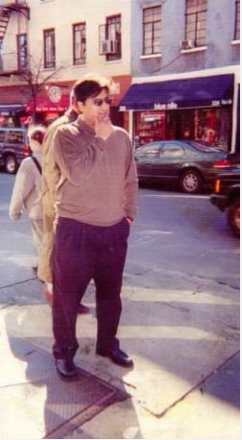Argument preview: Short-handed court to hear arguments in September 11 detainee case


It has been more than 15 years since the September 11, 2001, terrorist attacks on the United States, but litigation related to the attacks and the U.S. government’s response continues to wind its way through the courts. Next week the Supreme Court will hear oral arguments in one such case, filed by a group of Muslim men who were in the country illegally and were arrested after the attacks. In their lawsuit, the men contend that their rights were violated when they were held in detention centers under unreasonably harsh conditions until they were cleared of any connection to terrorism, even though federal officials knew that they had no such connection, because of their race and ethnicity.
As the case comes to the Supreme Court, the question before the justices is not whether the men’s rights were violated, but instead whether their claims against a group of federal officials can go forward at all. The U.S. Court of Appeals for the 2nd Circuit agreed with the plaintiffs and allowed several claims to proceed. The officials – former Attorney General John Ashcroft, former FBI Director Robert Mueller, and former INS Commissioner James Ziglar, along with Dennis Hasty and James Sherman, the wardens at the federal detention center where some detainees were held – now urge the Supreme Court to reverse that ruling and dismiss the claims against them, arguing that litigating the plaintiffs’ claims would entangle courts in questions relating to national security, intelligence, and immigration. But the plaintiffs counter that the officials must be held accountable for their actions to demonstrate the country’s “commitment to the rule of law” and to deter future constitutional violations.
There are three main areas of disagreement in the case. The first is whether the plaintiffs can rely on the Supreme Court’s 1971 decision in Bivens v. Six Unknown Named Agents, in which the justices ruled that a plaintiff can bring a private federal action for damages against federal officials who allegedly violated his constitutional rights. The federal officials emphasize that the Supreme Court has only extended its decision in Bivens twice to allow lawsuits based on new scenarios, and that it has not done so in nearly three decades. The justices should decline to extend Bivens here, they contend, because the plaintiffs’ cases involve precisely the kind of “special factors” that require courts to hesitate before allowing a remedy. The lower court failed to consider those factors, the officials argue, even though the case “arises from the Executive’s response to an unprecedented terrorist attack and the detention of foreign nationals illegally in the United States” – not to mention that the lawsuit seeks to hold “local jailers” accountable for failing to substitute their own assessments of the risks posed by the plaintiffs for those of the FBI. Instead, the officials argue, the lower court reached its conclusion that the plaintiffs’ Bivens action was not “new” only by approaching the question from a very high level of generality, without taking the very special circumstances of the case into account.
The plaintiffs respond that their claims are hardly novel, but instead fall squarely within the kinds of Bivens actions that courts have already authorized. For example, they note, the Supreme Court has allowed Bivens claims against “high-ranking Bureau of Prisons officials for mistreatment in federal prisons” – just like Hasty and Sherman. But even if their claims here would require the court to extend Bivens, they continue, it should do so because there aren’t any “special factors” that would counsel hesitation: The case does not actually involve either national security or immigration, particularly because their complaint specifically alleges that the federal officials were aware that the plaintiffs “were not individually suspected of anything related to terrorism.” If anything, they suggest, the involvement of high-level officials in crafting the policies that underlie this case weighs in favor of, rather than against, allowing the claims to go forward, because more deterrence is needed. “This is respondents’ only remedy,” they conclude, “and it is necessary to deter federal officials from violating the clearly established rights of those in civil custody, and to compensate the victims of such abuse.”
The next question before the court is whether the federal officials are entitled to immunity from the plaintiffs’ lawsuits. As a general rule, an official will have immunity unless a plaintiff can demonstrate that the official’s conduct violates “clearly established” law – a high bar. That bar is not met in this case, the federal officials contend, because here too the lower court’s analysis operated “at an impermissibly high level of generality” that did not take the specifics of this case into account.
The plaintiffs retort sharply that, by the time the conduct at issue in this case occurred, it would have been clear to federal officials “that they could not impose upon detainees arbitrary and purposeless prison restrictions bearing no reasonable relationship to a legitimate government interest, and certainly could not single out detainees for such restrictions on the basis of race, religion, or ethnicity.” Any argument to the contrary, they conclude, would be akin to an “attempt to revive the discredited legacy of” Korematsu v. United States – in which the justices upheld the federal government’s exclusion of U.S. citizens of Japanese descent from military areas during World War II.
The third and final question before the court relates to whether the plaintiffs’ complaint alleges facts that can survive a motion to dismiss. In Ashcroft v. Iqbal, the justices ruled that the complaint filed by a Muslim man held at a federal detention center, who alleged that his harsh treatment in prison violated the Constitution, needed to contain enough facts to demonstrate that the officials he was suing had implemented the policy to discriminate.
The plaintiffs are confident that they can meet this standard, asserting that their complaint contains “detailed factual allegations of the kind not present in” Iqbal. For example, they contend, they “plausibly allege,” they contend, that Ashcroft, Mueller, and Ziglar “crafted a policy that knowingly consigned Muslim men of Arab or South Asian descent, suspected of nothing but overstaying their visas, to extreme punishment.” They concede that, if their claims “prove to be unfounded,” the federal officials “will have opportunities to escape this litigation, including before trial.” “But at this early stage,” they conclude, they “have done enough to gain entry to the courthouse.”
Not so, say the federal officials. They tell the court that the plaintiffs’ complaint – far from containing “detailed factual allegations” – instead “relied on allegations of hypothetical possibilities, conclusional assumptions, and unsupported insinuations of discriminatory intent.” And in particular, they note, the plaintiffs’ complaint does not dispel the most likely explanations for the officials’ conduct. For Hasty and Sherman, for example, that would be that they were simply following the terrorism designations made by the FBI and policies established by the Bureau of Prisons; the other officials were trying to avoid allowing a dangerous person to leave the United States.
Under normal circumstances, the plaintiffs might have reason to be cautiously optimistic about their chances in the Supreme Court. Because a tie would leave the lower court’s ruling in their favor in place, they could win – for all intents and purposes – in the Supreme Court simply by securing four votes from the court’s more liberal justices. But two of those justices – Sonia Sotomayor and Elena Kagan – are recused from the case, presumably because they were involved in the earlier proceedings in their former jobs as a judge on the U.S. Court of Appeals for the 2nd Circuit and the U.S. solicitor general, respectively.
So even if the plaintiffs can secure the votes of Justices Ruth Bader Ginsburg and Stephen Breyer, they would still need to pick up at least one more vote for a tie. And that vote (as well as those of Ginsburg and Breyer) could be hard to come by. Just this week, the justices threw out a lower court ruling denying qualified immunity to a New Mexico police officer in a lawsuit alleging that the officer had used excessive force. In an unsigned opinion, without any noted dissents, the court took pains to emphasize that the concept of “clearly established law” is quite narrow. In particular, the court observed, clearly established law “should not be defined ‘at a high level of generality'” and should instead hew fairly closely to the specific facts of a case. That language could bode poorly for the plaintiffs in this case, but we’ll know more after next week’s arguments.
Posted in Analysis, Merits Cases
Cases: Ziglar v. Abbasi, Ashcroft v. Abbasi, Hasty v. Abbasi
